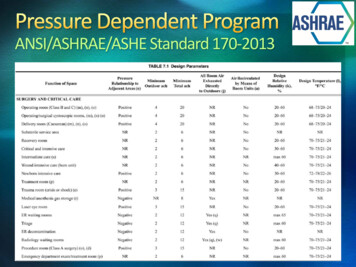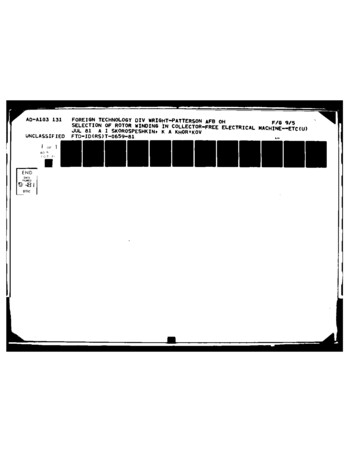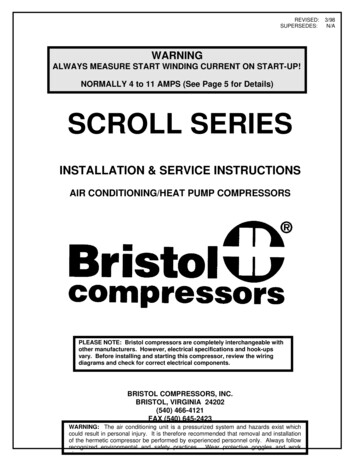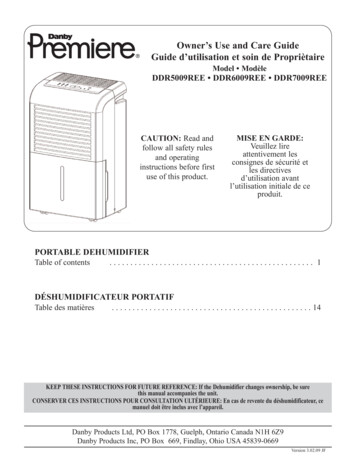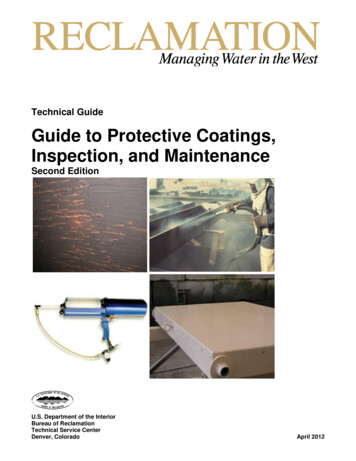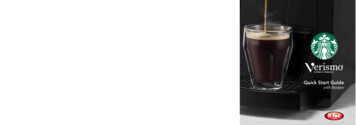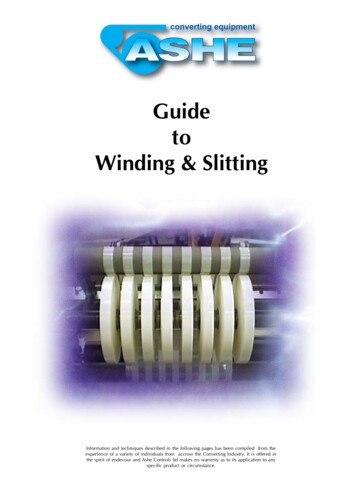
Transcription
GuidetoWinding & SlittingInformation and techniques described in the following pages has been compiled from theexperience of a variety of individuals from accross the Converting Industry. It is offered inthe spirit of endevour and Ashe Controls ltd makes no warrenty as to its application to anyspecific product or circumstance.
Winding & SlittingIntroductionWeb processors are challenged daily by the continuingintroduction of new and unique materials in plastics, film,paper, foil, laminates, tapes. nonwovens . . . Materialconditions. surface air and mechanical conditionsare the major problem areas associated with winding,which are discussed in this guide.This is followed by an analysis of basic slitting and winding techniques which should be helpful in solving theseproblems.Where appropriate, specific equipment is discussed interms of its usefulness in achieving optimum, efficient,quality production.
ContentsDEFINING PROBLEMSMaterial ConditionsGauge VariationGauge BandSlack ZonesSurface AirAs a lubricantEntrapmentBASIC SLITTING TECHNIQUESRazor Blade SlittingShear SlittingScore Cut SlittingBASIC WINDING TECHNIQUESCenter WindingDifferential RewindingCores and AdaptorsIndivedual Top Riding RollsPreventing Gauge Band Build-UpSurface-Center WindingSurface Winding
Material ConditionsAll films, coated materials and laminations are subject to some or all of the following variations:Gauge VariationA gradual uneven thickness across the web width from edge to edge.Gauge BandAn abrupt change in thickness in a small area. Gauge bands run parallel to the main axis of the web and canexist for the length of the web, or only for short lengths.Slack ZonesSlack Zones are caused by the uneven production of the original material. In this condition, the gauge can beeven, but if the web were laid out on a flat surface and cut into strips parallel to the machine direction, theslack zone strips would be longer than the normal or tight zone strips (Figure 1-1).Fig. 1-1. Slack ZonesSurface AirAll materials carry a surface layer of air with them as they move through a machine. When films are slit andrewound, the layer of air is carried into the rewound roll. At low speeds. this layer of air can escape at theends of the slit rolls without causing problems in winding. At high speeds, air is wound into the roll. Thiscan result in the air acting as a lubricant or becoming trapped between the layers of material. When air acts asa lubricant between the layers of material it allows shifting of the second, third, and lower layers (from theoutside in) within the axis of the roll (Figures 1-2 and 1-3).Fig 1-2Fig 1-3Fig 1-2 and 1-3 Air wound between layers showind the relative shifting of the materialWhen air is trapped between the layers of material and is wound into the roll, it forms tires, balloons or bubbles, causing deformation and occupying volume as a secondary layer (Figure 1-4). This causes poor rollformation and deformation of the web.Fig. 1-4. Air Trapped in Rewound Roll1 00 01
BASIC SLITTING TECHNIQUESRazor Blade SlittingShear SlittingScore Cut Slitting
Basic Slitting TechniquesThe type and thickness of material determines whether shear cut, razor blade or score cut slitting should beemployed. For example, soft films such as polyethylene, vinyl and polypropylene are cut quite easily by razorblades, as are the light gauges of polyester. Heavier gauges of polyester, starting at .002" thick should be shearcut, as should paper foil, and most laminates of the above. Score cut slitting is usually employed where speedof set-up is more important than the quality of the slit edge or the material is too abrasive for shear or razorblade slitting.Razor Blade SlittingIf original equipment cost, cost of knives and speed of set-up alone were used as a criterion,only razor blade slitting would ever be used. However, razor blades cannot be set to hold close slitting tolerances, nor are they capable of cutting through heavy rigid, or abrasive materials.Figure 11-1 shows razor blade slitting in air and Figure 11-2 razor blade slitting in a grooved roll. Of thesetwo, the use of the grooved back up roll with the web wrapped around the roll. provides for a cleaner,smoother and more accurate cut because, the roll gives very close support to the web as it is being cut. Itcannot stretch or shift under the blade as it can when slitting in air between two rolls. If the web runs. tangential to the grooved roll rather than wrapping around it, the benefits of the grooves are lost.Fig II-1 Razor Blade Slitting in AirFig II-2 Razor Blade Slitting in Grooved RollSet-up of razor blade slitting in air is faster, but also results in a loss of accuracy in slitting. The grooved rollrequires more set-up time because the blade must be centered in the groove not touching either side or thebottom. Contact between the razor blade and the grooved roll quickly destroys the blade and tends to damagethe groove.Figures 11-1 and 11-2 also show the most commonly used method of having the blade penetrate the web.However, recent tests have shown that much cleaner cuts are obtained by using the method shown inFigure 11-3.Tangential Razor SlittingFig. 11-3. Grooved Roll. Magnified SectionIn this arrangement the film touches only the finely honed area of the blades keeping abrasion of the film to aminimum. When hollow ground blades are used there is less interference between the blade and the filmbeing cut.At nominal running speeds, say through 1500 FPM the blades also tend to burnish the film as it is being slitgiving a polished edge. Over these speeds heat is generated. If enough heat is generated to start melting thefilm. a bead can be generated at the slit edge. This bead can be very detrimental to achieving good winding ofthe slit strips.The razor blade is the most economical of the knives used for slitting. Set-up is easily accomplished just byclamping a blade in place along a bar so that the blade penetrates through the web. Hence razor blade slittingcan be recommended for quality and for fast set-up on any light, non abrasive materials.2 00 02
Shear SlittingShear cut slitting uses two rotary knives to produce the same cutting effect as obtained by using a pair ofscissors. Scissors present a condition with two sharp blade edges crossing at an angle as is shown in Figure 114. To cut the material it is necessary to apply force on the handle of the scissors. The cutting takes place at thejunction of the two sharp edges, and as the scissors close, the angle of the junction gets smaller. As the anglechanges, the cutting effect changes. There is an ideal angle at which a material will cut. We have all triedtaking scissors, holding them open, and pushing them through a sheet of paper. At a certain angle they cutcleanly and very easily. Change the angle slightly. and the paper tears. This is exactly what happens with apair of rotary knives.If the web is running slower than the knives, effectively the knife is closing in on the web or cutting it the wayscissors cut. If the web is running faster than the knives, the effect is the same as pushing the material throughthe scissors. This is why material can be effectively slit at a knife speed which is either slower than synchronous, synchronous with the web. or faster than synchronous. The angle of junction between the knife cuttingedges is the critical factor.Fig. 11-4. Shear Slitting PrincipleChanging the analysis from scissors to two rotary knives, there are two circles that overlap and form a junctionangle.(Figure 11-5) similar to that formed by the scissors. Squeezing the blades together creates a reactionforce which pushes the blades apart. This is the, same force that is used to squeeze the handle of the scissors.When a large number of cuts are being made. these reaction forces can bend a knife shaft. This is a factor thatmust be considered in all slitting applications. No table of the shearing forces required for various materials isyet available.Fig. 11-5. Shear Slitting As Applied to Rotary Knives2 00 03
At the present. we are using a figure of approximately a pound. to a pound and a half per cut per mil of material thickness. Also uncertain, at this time, is the effect that the relative speed between the material and theknives has on the shearing force. This is also being studied. We now feel that when the knives are runningfaster. the unit shearing force is less, because less material is being cut per knife revolution than would be atsynchronous speed. Hence higher knife speed results in lower shearing forces. Also under study is the relationship between knife speed and slit edge quality. There is some indication that faster speeds are better forfoil. To date most plastic films and paper are slit at synchronous speed with excellent results. On mostmaterials. problems exist at speeds below synchronous. These are generalities that can be made about cuttingeffects and the relationship between scissors and shear knives.Next, consider the configuration of the web and the knives in the machine. There are two primary arrangements: “Wrap Slitting" and "Kiss Slitting". The preferred arrangement is "Wrap Slitting". Here the web actuallywraps around the female knife and is positively supported while being cut.Fig. 11-6. Web Wrap Around Female Knifeas shown in Figure 11-6. The arc of contact between the web and the female knife must be greater than the arcof contact between the male knife and the female knife. See Figure II-7 the arc of web contact is smaller thanthe arc of knife contact, the male knife hits the unsupported section of the web, The web is, therefore, tornrather than cut. This condition is illustrated in Figure 11-8. Knives and spacers must be assembled on the shaftto form or to simulate a solid supporting shaft. Unless the web is supported by a shaft solidly stacked withknives and spacers, the web will pull or sag into the voids and irregular slit widths will result.Fig. 11-8. Detail of Contact ArcFig. 11-7. Arc of Contact betweenMale Knife & Female Knife2 00 04
The second arrangement is tangential or kiss slitting. In this arrangement the web only kisses or touches theoutside diameter of the female knife, it doesn't wrap around it. See Figure 11-9. If the web hits the male knifebefore it hits the female. a cutting angle is not achieved. This is the same as taking scissors and trying to cutwith only one blade. The web is ruptured, not cut. Conversely, if the web hits the female knife first. nothinghappens, but, when it leaves the female and hits the male, again the web is ruptured. A clean cut is notachieved. It is essential in kiss slitting that the female knife. the web and the male knife, contact eachother atthe critical point. This critical point will change as the male knife overlap is increased; therefore, you cannotincrease the over- lap beyond an ideal condition without creating problems. This ideal condition is minimumoverlap and point contact. Increasing overlap increases the arc of contact between the two knives and the maleknife hits the web before the female. Using a male knife of a smaller diameter will give a greater overlapbefore reaching the critical point. See Figure 11-1 0. The large diameter male knife has a larger arc of contactfor the same overlap. Therefore. the smaller the diameter ofFig. 11-9. Kiss SlittingFig. 11-10. Detail of Contact Arc Wrap Slittingthe male knife, the greater the permissible amount of overlap. The greater the diameter of the male knife, thesmaller the permissible overlap. The large radius will give a bigger arc as you increase the overlap. To thisdegree, the individual knives, permitting fine adjustment of each individual knife, give better control thanmultiple knives mounted on a single shaft where additive tolerances must be overcome by increasing theoverlap.The advantage of kiss slitting is fast setup of individual female knives. These knives can be repositioned on theshaft without removing the entire-knife shaft. Wrap slitting requires the removal of the shaft from the machine,taking off the knives and spacers and then putting them back in rearranged order. In kiss slitting. the knife isloosened, shifted to the next cutting position, and tightened again. It can be accomplished in a minimum oftime in the machine without removing any parts from the machine. The disadvantage lies in the quality of cutachieved. The cut is not as good as that obtained by wrap slitting. In wrap slitting. the web wraps around thefemale knife. The male knife penetrates to the ideal depth and gives a good clean cut. In kiss slitting, the webcomes in tangential to the female knife. When the web and the male knife come in contact at this same pointthe cut is clean. To achieve this geometrical arrangement the male knife must be offset toward the exiting sideof the web. Looking at Figure 11-1 1. you will notice that a good portion of the male knife now is undemeaththe web that has been cut. As the male knife rotates out of the web, the web rubs both on the cutting side andthe backside of the male knife, creating a frictional drag and filing the material that passes through. This is adecided disadvantage because it causes fuzz and, dust.Fig. 11-1 1. Comparison of Rub Areas in Kiss SlittingDepending on Web Path2 00 05
Looking at Figure 11-12, it is seen that when shear slitting a web, on the cutting side the male knife comes inand cuts clean and square. On the other side, the knife has pushed the web aside and down in the cuttingoperation. Consequently, the web, depending upon the condition or type of material being slit, can be permanently or temporarily deformed. The edge of foil, for example, takes a permanent deformation on the edge,and as it winds up layer after layer, builds a bevel on the edge of the rewound roll which eventually causes thesheet to tear. In foil, this deformation occurs with both kiss and wrap slitting.There is a second problem that arises in kiss slitting. When the
giving a polished edge. Over these speeds heat is generated. If enough heat is generated to start melting the film. a bead can be generated at the slit edge. This bead can be very detrimental to achieving good winding of the slit strips. The razor blade is the most economical of the knives used for slitting. Set-up is easily accomplished just by
